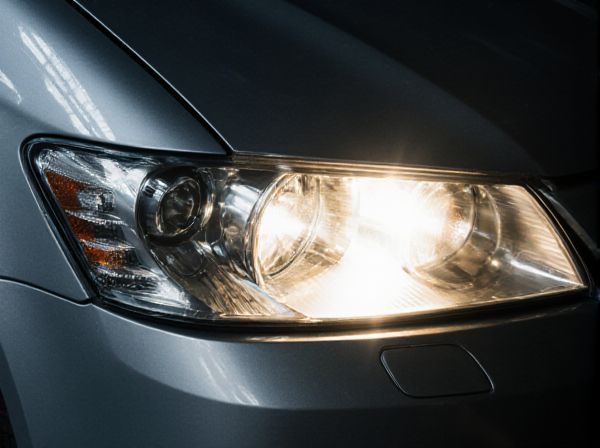
Photo illustration: Shutter-Type Low-Beam vs Solenoid-Type Low-Beam
Shutter-type low-beam headlights use a mechanical flap to block part of the light, providing a sharp cutoff line that reduces glare for oncoming traffic. Solenoid-type low-beam headlights rely on an electromagnetic solenoid to move the reflector or lens, adjusting the beam pattern quickly and precisely. Understanding the differences between these technologies helps you choose the best lighting system for safety and performance.
Table of Comparison
| Feature | Shutter-Type Low-Beam | Solenoid-Type Low-Beam |
|---|---|---|
| Mechanism | Uses a mechanical shutter to block high-beam light | Uses a solenoid to physically shift the bulb or reflector |
| Response Time | Slower due to shutter movement | Faster with quick solenoid actuation |
| Durability | More mechanical wear over time | Less mechanical wear, more reliable |
| Light Output | Possible light leakage reduces beam quality | Precise light cut-off for better beam focus |
| Maintenance | Higher maintenance due to moving shutter parts | Lower maintenance with fewer moving components |
| Common Usage | Older vehicle headlight systems | Modern vehicle lighting systems |
Introduction to Low-Beam Headlight Technologies
Shutter-type low-beam headlights utilize mechanical shutters to block part of the light beam, providing a sharp cutoff that reduces glare for oncoming drivers while maintaining optimal road illumination. Solenoid-type low-beams employ an electromechanical solenoid to retract or deploy a shield within the headlamp assembly, enabling precise control of beam patterns for improved safety and visibility. Both technologies enhance driver experience by dynamically adjusting light distribution to meet regulatory standards and adapt to varying driving conditions.
Overview of Shutter-Type Low-Beam Mechanism
Shutter-type low-beam mechanisms control light distribution by using a movable shutter within the headlamp to block part of the high-beam light, creating a precise cutoff line that reduces glare for oncoming traffic. This mechanical shutter swiftly adjusts to switch between high and low beams, providing consistent light quality and improved beam pattern control. The design enhances safety and visibility without requiring additional light sources or complex electronics.
Solenoid-Type Low-Beam: How It Works
Solenoid-type low-beam headlights operate using an electromagnetic solenoid mechanism that shifts the bulb or reflector to change the beam pattern. When powered, the solenoid activates a metal arm or lever to move the light source, producing the appropriate low-beam cutoff for oncoming traffic. This system enables quick, reliable beam adjustment without the need for complex gears or motors, enhancing durability and reducing maintenance in automotive lighting.
Key Differences Between Shutter-Type and Solenoid-Type
Shutter-type low-beam headlights use a mechanical shutter that adjusts the light beam pattern by partially blocking the light, offering precise beam control and reduced glare for oncoming traffic. Solenoid-type low-beam systems rely on an electromagnet that physically moves the reflector or bulb to change the beam position, providing quicker response times but potentially less accuracy in beam shaping. The key differences lie in the mechanism of beam adjustment--shutter-type emphasizes exact light cutoff with minimal light loss, while solenoid-type prioritizes rapid mechanical movement for beam switching.
Light Output and Beam Pattern Comparison
Shutter-type low-beam headlights provide a precise cutoff line by physically blocking the light to prevent glare, resulting in a sharp and well-defined beam pattern ideal for urban driving. Solenoid-type low-beam systems rely on mechanical movement to adjust the reflector or bulb position, often producing a slightly less consistent beam pattern with potential light scatter. In terms of light output, shutter-type headlights typically maintain higher lumen efficiency due to controlled light distribution, while solenoid types may experience minor losses from reflector adjustments.
Reliability and Durability Aspects
Shutter-type low-beam headlights offer enhanced reliability due to fewer moving parts and less exposure to environmental contaminants, resulting in longer operational lifespan and consistent light performance. Solenoid-type low-beam systems involve mechanical actuation with solenoids prone to wear and potential failure from repeated use or electrical issues, which may reduce overall durability. Choosing shutter-type technology typically ensures greater resilience in harsh conditions, improving vehicle headlight longevity and minimizing maintenance needs.
Energy Efficiency and Power Consumption
Shutter-type low-beam headlights offer enhanced energy efficiency by mechanically blocking part of the high beam, requiring minimal power for operation compared to continuous electrical energy usage in solenoid-type low-beam systems. Solenoid-type low-beam headlights consume more power due to electromagnetic activation, which causes increased electrical load and heat generation. Optimizing energy consumption in automotive lighting favors shutter-type mechanisms for improved fuel economy and reduced battery drain, especially in electric vehicles.
Maintenance and Repair Considerations
Shutter-type low-beam headlights typically require less frequent maintenance due to fewer moving parts but may demand specialized repair skills when issues arise with the shutter mechanism. Solenoid-type low-beam systems involve solenoid actuators that can wear out over time, necessitating timely replacement to maintain proper beam alignment and function. Both types require regular inspection of electrical connections and mechanical components to ensure optimal performance and longevity.
Application Suitability: Which Vehicles Benefit Most?
Shutter-type low-beam headlights excel in modern vehicles equipped with adaptive lighting systems and require precise beam shaping, commonly found in premium sedans and SUVs for enhanced nighttime visibility. Solenoid-type low-beam headlights are more suitable for traditional vehicles with simpler lighting designs, often seen in economy cars and older models where durability and cost-efficiency are priorities. Vehicles with advanced driver-assistance systems (ADAS) benefit most from shutter-type headlights due to their dynamic control, while solenoid types serve best in basic lighting setups demanding reliable and straightforward operation.
Conclusion: Choosing the Right Low-Beam Technology
Shutter-type low-beam headlights offer precise light cutoff and enhanced beam control, making them ideal for vehicles requiring sharp, adaptive lighting. Solenoid-type low-beam systems provide reliable, quick mechanical actuation suitable for cost-effective or simpler headlight designs. Selecting the right low-beam technology depends on balancing factors such as vehicle application, desired beam precision, cost constraints, and maintenance preferences.
 caratoz.com
caratoz.com